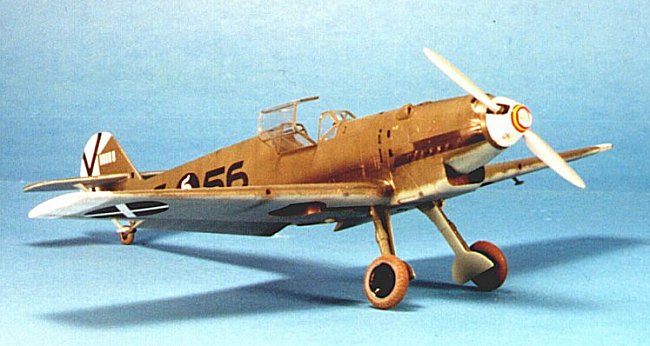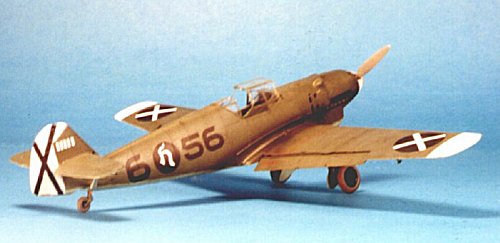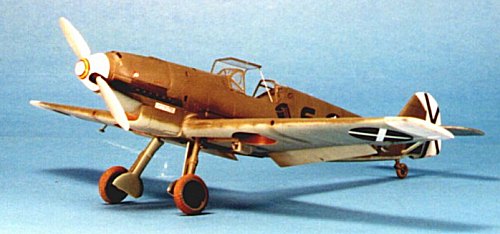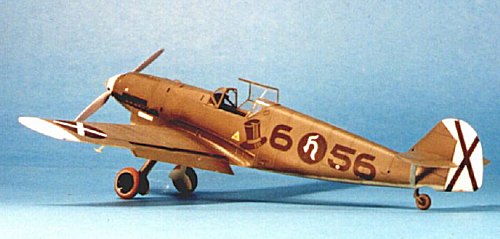
|
KIT: |
Hobbycraft 1/48 Bf-109D |
|
KIT # |
|
|
PRICE: |
$13.00 |
|
DECALS: |
See review |
|
REVIEW & |
|
|
NOTES: |
|
HANDRICK'S DORA: A Little Lesson in Historic Deduction

|
HISTORY |
On July 25, 1936, Adolf Hitler was approached in Berlin by a representative of General Francisco Franco, leader of the Nationalist insurgents who had recently rebelled in Spanish Morocco against the Republic of Spain. Franco asked for a few Ju-52 transports to assist him in moving his troops from Spanish Morocco to the Spanish mainland. Hitler saw this as the opportunity to test his new Luftwaffe, and agreed immediately. Not only did he send a few Ju-52s, he sent a full sized air fleet, soon to be known as the Condor Legion. Thus was set in motion the first movement of the overture leading to the Second World War.
In addition to the Ju-52s, a shipment of six He-51s, with pilots and groundcrew sufficient to instruct the Spanish pilots and crews in the operation and maintenance of the aircraft,under the leadership of Ltn. Hannes Trautloft - "on leave" from 9/JG134 - were sent by sea, arriving that August. Shortly after the airplanes were assembled, it became clear that the Spanish pilots were in no way ready to take them into combat; Trautloft and the other five pilots became the first of 126 officers and 200 non-commissioned officer pilots who would serve with Jagdgruppe 88 during the next two and a half years of conflict.
Shortly thereafter, Soviet aid arrived for the Republican forces in the form of I-15 and I-16 fighters and Red Air Force pilots to fly them. Both Soviet fighters easily outperformed the underpowered He-51s, and soon the Condor Legion's fighter pilots were on the defensive. The situation was so bad that at the end of 1936, three Bf-109 prototypes were sent to the unit, followed by more Bf-109Bs in advance of their equipment of the regular units of the Luftwaffe inside Germany. The Bf-109s, coupled with superior German tactics developed by Ltn. Werner Moelders, turned the tide of aerial battle decisively in favor of the Condor Legion.
 The most famous at the
time among the pilots who flew in Spain was Hauptmann Gotthard Handrick,
winner of the modern pentathlon at the 1936 Berlin Olympics. Handrick arrived in
Spain in the summer of 1937 to assume command of Jagdgruppe 88, remaining
in combat until July 1938, during which time he scored 5 victories. He later
commanded I/JG26, and later was Geschwader Kommodore during the Battle of
France; his career as a fighter pilot in World War II was undistinguished, and
he soon was promoted out of this position to become a staff officer, which
position he held throughout the rest of the war.
The most famous at the
time among the pilots who flew in Spain was Hauptmann Gotthard Handrick,
winner of the modern pentathlon at the 1936 Berlin Olympics. Handrick arrived in
Spain in the summer of 1937 to assume command of Jagdgruppe 88, remaining
in combat until July 1938, during which time he scored 5 victories. He later
commanded I/JG26, and later was Geschwader Kommodore during the Battle of
France; his career as a fighter pilot in World War II was undistinguished, and
he soon was promoted out of this position to become a staff officer, which
position he held throughout the rest of the war.
The Mystery of Handrick's Dora:
Students of the conflict know that during Handrick's tour of duty with J88, the unit was solely equipped with the Bf-109B, until 3/J88 was equipped with Bf-109Ds in the summer of 1938. Though no photographs of Handrick from this period have been discovered, it has always been assumed he flew a Bf-109B like everyone else. The problem comes with the additional fact that the only photographs of him with a Bf-109 are from the summer of 1938, when he is seen with 6-56, which by this serial number is identified as a Bf-109D. Some "researchers" have explained this away by deciding he must have had a "specially marked" airplane which was serialled out of sequence for him as Gruppenkommandeur, since the unit "only" had Bf-109Bs during his tour.
There is a far easier and more likely explanation:
In the recent "Luftwaffe Colours Volume 2," by Erik Mombeek, the largest number of photos of Handrick's '109 are assembled that have been published anywhere. A study of these photos reveals they were likely all taken around the same time: the airplane has little weathering or operational wear; there is no difference in coloration from sun-bleaching as would happen in Spain over a short period of time; and Handrick's full score of five kills is shown on the rudder. If one couples these items with the fact that the airplane later became the personal mount of Walter Grabmann, Handrick's successor as Gruppenkommandeur, the solution starts to become clear. Photos of the airplane when Grabmann used it show an airplane that has been used: it has exhaust stains and other signs of operational wear.
Throughout the Second World War, on all sides, it was not uncommon for publicized pilots to be provided a special mount for photographic purposes. Almost invariably, this was a little-used machine. One can think of William Shomo's well-known "Flying Undertaker," which cannot possibly be the airplane he flew on his Medal of Honor mission since it is a P-51D and Shomo was in an F-6D photo recon variant - the airplane was taken over by the Air Force publicity force, prettied up for photos, and accepted as "Shomo's Mustang" for 30 years until photos of the real airplane were found by serious researchers. "Marion Carl's Wildcat" is another of these, a hangar queen back at the main base away from Guadalcanal, hurriedly "stickered" with Japanese flags while Carl's name was painted on the canopy, so the famous ace could be photographed upon his return from duty at Guadalcanal, where no one had a "personal" airplane but rather flew whatever airplane was operational at the time.
The Answer:
 My hypothesis regarding
"Handrick's Dora" is that the German propaganda service realized no
one had taken any photos of the famous ace during his tour of duty; with his
return to Germany imminent and photos needed for the upcoming publicity
campaign, a recently-arrived Bf-109D was quickly given his kill markings and a
"personal insignia" related to his Olympic glory (and the hopes for
1940) added where it could be easily photographed with Handrick standing in
front of the airplane. The airplane likely was "Handrick's" for the
day it took to take the roll of film, and saw no operational service until flown
by Grabmann.
My hypothesis regarding
"Handrick's Dora" is that the German propaganda service realized no
one had taken any photos of the famous ace during his tour of duty; with his
return to Germany imminent and photos needed for the upcoming publicity
campaign, a recently-arrived Bf-109D was quickly given his kill markings and a
"personal insignia" related to his Olympic glory (and the hopes for
1940) added where it could be easily photographed with Handrick standing in
front of the airplane. The airplane likely was "Handrick's" for the
day it took to take the roll of film, and saw no operational service until flown
by Grabmann.
I have discussed this idea with Erik Mombeek, who agrees that it is the easiest answer that takes into consideration all the known facts; unfortunately, with Handrick and his wife both long dead, and most of the men who were there at the time also gone, there is little chance of obtaining independent testimony on this. There is a term used in scientific research, "Occam's razor," which says that the simplest explanation that fits the facts is likely the truth. I think this meets the requirements of old Occam.
The Airplane:
Once the provenance of the airplane has been explained, there is an additional question to be asked: how exactly was it marked? A study of the photos in Mombeek's volume shows that the airplane is significantly darker than other Bf-109s on its upper surfaces. This could be due to its newness, while the other airplanes have been subject to the Spanish sun. I think there is another explanation.
In their research on the early Luftwaffe, Mombeek and his profile artist, Tom Tullis, have determined that German fighters were mostly painted RLM63 Grey, a shade they show as considerably more greenish in tone than others have determined. They also present evidence that this is "prewar" RLM63, and that the later grey most are agreed on was a wartime color. They also state that RLM02 was used as an interim camouflage color between RLM63 and the later scheme of 70/71 on upper surfaces.
 Interestingly, the color
they claim as RLM63 is an almost-exact match for what Gunze Sanyo has called
"RLM02" in their paint line. This color is considerably lighter than
the RLM02 presented by other paint manufacturers; given that the paint came from
many manufacturers, the color probably varied considerably, and they could have
based theirs on one of these samples. On the other hand, they might have
mistaken prewar RLM63 for RLM02; given the amount of misinformation that has
existed around Luftwaffe colors for the past 50 years, this would not be a
surprise. Additionally, the color Tullis calls for RLM02 is an almost-exact
match of Tamiya "RLM Grey," a color considerably darker than RLM63. If
indeed Handrick's Dora is painted RLM02 on its upper surfaces and the other 109s
are painted RLM63, this explains the tonal difference in the photographs. The
fact that other Bf-109Ds are shown in this darker shade would agree with the
idea of RLM02 being a color used between RLM63 and the later 70-71
"splinter scheme."
Interestingly, the color
they claim as RLM63 is an almost-exact match for what Gunze Sanyo has called
"RLM02" in their paint line. This color is considerably lighter than
the RLM02 presented by other paint manufacturers; given that the paint came from
many manufacturers, the color probably varied considerably, and they could have
based theirs on one of these samples. On the other hand, they might have
mistaken prewar RLM63 for RLM02; given the amount of misinformation that has
existed around Luftwaffe colors for the past 50 years, this would not be a
surprise. Additionally, the color Tullis calls for RLM02 is an almost-exact
match of Tamiya "RLM Grey," a color considerably darker than RLM63. If
indeed Handrick's Dora is painted RLM02 on its upper surfaces and the other 109s
are painted RLM63, this explains the tonal difference in the photographs. The
fact that other Bf-109Ds are shown in this darker shade would agree with the
idea of RLM02 being a color used between RLM63 and the later 70-71
"splinter scheme."
I chose to do my model with RLM65 Hellblau lower surfaces and RLM02 RLM grau upper surfaces, using Tamiya paints. I think the result is compelling in its similarity to the black and white photos when I scan a color shot in grey scale.
|
THE KIT |
Hobbycraft of Canada released the early Bf-109s in 1992. The models have been out of production for years, though they can be found at good prices on dealer tables at model shows. Additionally, Academy has licensed the Bf-109D kit from Hobbycraft and recently released their version, which should be widely available.
These are excellent kits, and allow the modeler to create the early Bf-109B with wooden propeller, and the Bf-109C and Bf-109D - which are primarily distinguishable by differences in the exhaust stacks. It's fairly obvious on examining the models that Hobbycraft had closely checked the Hasegawa Bf-109E models, though the Hobbycraft interior is more detailed than that provided by Hasegawa as regards the sidewalls. The canopy is thick and best replaced by a Squadron vacuform early 109 canopy which was made specifically for the kit.
|
CONSTRUCTION |
The model was essentially built out of the box, other than addition of a piece of Evergreen sheet as a bulkhead inside the wing in the flap area so there was something to attach the lowered flap to. Additionally, I used a Hasegawa Bf-109E canopy from the spares box; this doesn't quite fit, but making the rim for the cockpit from .010 Evergreen sheet solved the fit problem perfectly.
|
PAINT & DECALS |
As stated above, the model was painted with Tamiya Flat White for the theater markings, and camouflaged RLM02 and RLM65. The model was then "Futured," and was ready for decals.
Aeromaster has produced four sets of decals to go with the first two volumes of the Luftwaffe Colours books. I used 48-458, "Spanish Civil War Part 1", which has Handrick's markings - including the Olympic personal markings - in exquisite detail. These went down with no problems.
After another coat of Future, the model was airbrushed with "Flat Future," my mixture of 30% Tamiya Flat Base with 70% Future, and three coats were applied to bring it to the level of "almost flat" that the airplane had in reality.
|
CONCLUSIONS |
Modeling is supposed to be a way of "making history come alive," and a project like this does exactly that. To come to these conclusions, one needs a bit of historic knowledge of the military publicity machine - an organization interchangeable between various armies - and a willingness to not accept what "the experts" have to say; mostly the most recent expert is merely quoting the one previous, who is quoting the one previous, back to the one who made the original mistake. Fortunately, researchers like Erik Mombeek and Tom Tullis are clearing away that underbrush so we can see what was really going on. To me, this kind of modeling is what makes it fun.
If you would like your product reviewed fairly and quickly by a site that has over 800 visits a day, please contact me or see other details in the Note to Contributors.